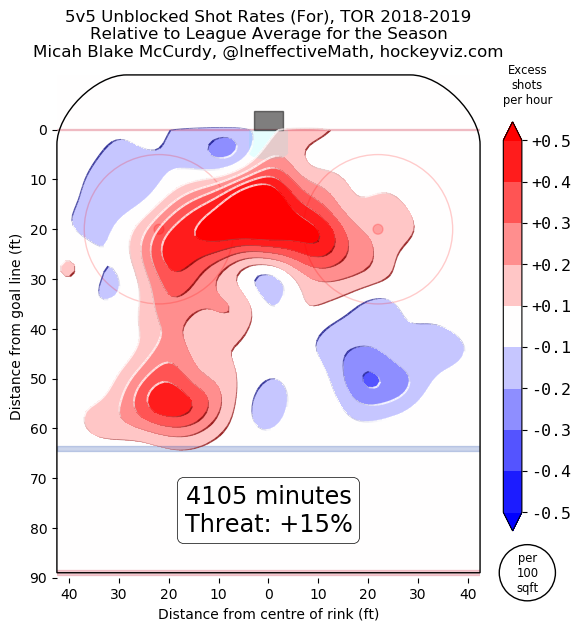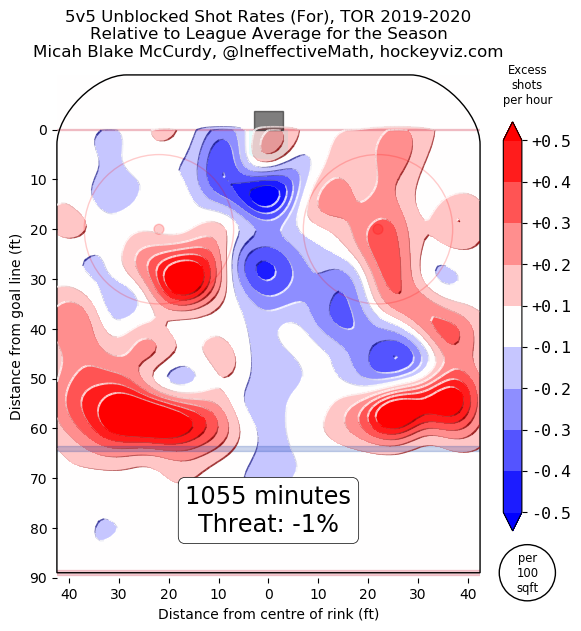Maple Leafs' offensive mess directly connected to shot location
The Toronto Maple Leafs were a very good team last season no matter how you look at it. But nothing stays the same and they have demonstrated almost the exact opposite tendencies through the first 22 games this season.
Last season, they were able to consistently roll their complete offence and not worry about individual performances, depending on their depth and having at least a couple players produce each game.
That led them to scoring a total of 206 goals at 5-on-5 — tying the highly-praised Tampa Bay Lightning for the league’s lead in 2018-19.
The way that the Leafs were able to get that large number of tallies was fairly simple: get to the front of the net for your shot attempts, since those are more likely to go in.
Among all 31 teams, Toronto sat third in high-danger shot attempts at 5-on-5, with a total of 830. Only the San Jose Sharks (831) and Carolina Hurricanes (900) were able to get more shots off in-tight.
Sacrificing quantity for quality was the Leafs’ identity last season and it clearly worked.

Overall, the team was able to get unblocked shot attempts in that high-danger area between the faceoff dots and close to the net. That led them to a +15% threat level — a metric developed by Micah Blake McCurdy to compare teams and players to league average — which was one of the best in the NHL.
Because of this strategy, the Leafs had the fourth-best expected goals for rate (2.55 xGF/60) in the league. It makes sense that shots taken closer to the net result in a better likelihood of becoming an actual goal, doesn’t it?
Comparing the 2018-19 team to this season’s is like comparing Curb Your Enthusiasm to The Big Bang Theory.

Looking close to the exact opposite of each other — except the left side of the blue line — the graphics above tell the story of the Leafs’ offence at 5-on-5 between the two seasons. The entire team has not been generating enough in areas where they are likely to see their shot attempts become goals.
Like a swinging pendulum, the Leafs are drawn towards the outside of the offensive zone to get their shots off. This has been a significant reason why they have not been able to get the production similar to last season.

The shot attempt rate (CF/60) is still among the best in the league but the quality and expected goal rate (xGF/60) of those shots have decreased in a catastrophic way.
A lot of that has to do with where — and whom — the shots are coming from.

Vaguely hinted at in this year’s heatmap of unblocked shots, the majority of the Leafs’ attempts are coming from the defencemen stationed on the blue line.
Even though Tyson Barrie has played more minutes than forwards like Auston Matthews and William Nylander, to even be within the same region of individual shot attempts (iCF) is absurd considering the Leafs’ talent up front.
With defencemen like Morgan Rielly, Jake Muzzin, and Barrie controlling the puck and getting shots off, that’s less of the offensive chances given to the highly-skilled forwards that Toronto employs.
But when the forwards do get those high-danger chances, they’re able to score on the majority of them. With 24.56 per cent of their high-danger shot attempts becoming a goal, only the Nashville Predators have a higher shot percentage in the “home plate” area in the NHL.
Considering that amount of turnover, it’s odd that this team continues to keep their shots from distance.
This decision — if it is on purpose — has led the Leafs to their bottom-tier expected goals rate. Very few teams are actually successful in this “pepper the net from extremely far away” strategy.

Comparing quality and quantity among teams, it’s an extremely clear picture of how teams are getting their offensive chances.
Teams such as the Vancouver Canucks, Carolina Hurricanes, and Pittsburgh Penguins can get the majority of chances while also keeping them to a high quality and have been rewarded for it this season.
Even if the Leafs rack up some wins in this upcoming road trip, but continue this tactic of long-distance shooting, the floor beneath them should eventually fall. It just seems illogical on the most basic instincts to attempt more shots from the blue line than they do close to the net.
Last year, it appeared the Leafs decided that getting shots off from in close was their optimal way of scoring more goals than the opponent, but something clearly changed and the team is in a free fall because of it.
All stats used from Natural Stat Trick or HockeyViz.
More Leafs coverage from Yahoo Sports

 Yahoo Sports
Yahoo Sports 


